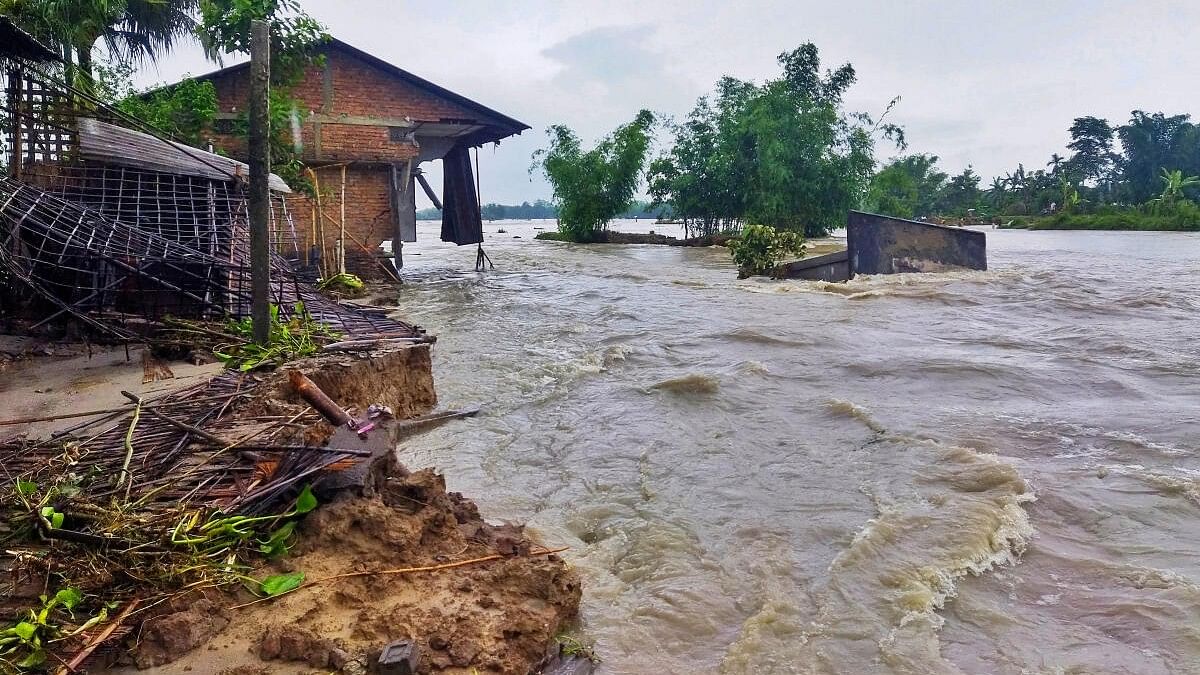
Several houses damaged as the flood water makes its way, in Lakhimpur district, Assam.
Credit: PTI Photo
North Lakhimpur: It has been nearly two-and-a-half-decades since a bustling village perished to erosion in Assam's Lakhimpur district, and for an entire generation, homes were all but temporary shacks on the embankment of river Subansiri.
The residents of Kasomari village, which was swept away following floods in 2001, were finally rehabilitated in 2018 to the ‘No. 1 Hindu Adarsha Gaon’ (model village), about five kms from here.
Locals, however, claimed that the process of land allotment and introduction of welfare schemes have moved at a glacial pace in the new village, though Lakhimpur MP Pradan Baruah maintained that swift progress has been made in the last couple of years.
Monikanta Das, a resident of the model village, said they had got in touch with the state government for land soon after settling on the embankment, but it was only in 2012 that the land advisory committee approved a plot for rehabilitating them.
"For over five years, due to some political pressure, we were not handed over the land. It took a Right to Information Act application for the allotment to be made on April 9, 2018," Das claimed.
Allotment was made for 153 families as per the original list, though the number increased to about 220 by 2018.
"Moreover, each family was given only a small piece of land for building houses. We were also told funds will be provided under the Model Village Scheme, but are still awaiting it," Das, in his late 40s who sells fish at the local market, said.
Another villager said due to non-allotment of agricultural land, they have to work as daily wage labourers in nearby areas to eke out a living.
"We are a family of seven members, but don't have land for cultivation. I appeal to the government to provide some land for farming," he said.
Annual flooding followed the villagers to their new address, too, with the women facing more difficulties in such situations, said Matu Das, a housewife.
"During floods, people cannot move around. If any house at an elevated level has a toilet, we use it. We somehow survive the monsoons," she said.
Das said some government facilities like ration card, health insurance and subsidised LPG cylinders have been made available to them, but many like her are still awaiting enrolment in the 'Orunudoi' scheme, under which the woman of the house receives Rs 1,250 per month in their bank accounts.
A worker at the local anganwadi centre claimed it is also in a state of neglect in this model village, inhabited by people belonging to the Scheduled Caste.
Deepa Chutia Das of the Kolioni Anganwadi Kendra said her repeated pleas before the authorities to fix the centre, which needs proper roofing and bamboo walls, have fallen on deaf ears.
'I have submitted applications to our office. We also send photos of the kendra on a daily basis. The authorities are well aware of the situartion, but do nothing,' she said.
Chutia Das said many children who come to the centre also refuse to eat the packaged food provided to them due to quality issues, and she has informed her seniors about the matter.
MP Pradan Baruah, who is seeking a third successive term from Lakhimpur on a BJP ticket, however, asserted that work for providing basic public infrastructure has started.
'We arranged for land for these people, and we are now gradually trying to provide them with the infrastructure. Facilities like ration card and electricity connection have already been made available. But, there are some people who have not been allotted houses, and there is the problem of water logging, too,' Baruah said.
Gokul Bharali, a local youth, who, along with a few others, strive to address some of the issues faced by the villagers, said work has been fast-tracked in the last couple of years.
Bharali claimed that a main road is being constructed, Rs 5 lakh has been allocated for a 'namghar' (community prayer hall), a water tank was built at a cost of Rs 1.5 crore, and Rs 8 lakh has been provided for building toilets and providing drinking water facility at the local school.
He also said that most families have got houses under the Pradhan Mantri Awas Yojana, while agreements for more have been signed and funds for the beneficiaries will likely be released after the Lok Sabha elections.
'Some villagers may try to indulge in party politics. But for us, development of our village comes first and we will work together with the ruling regime to address concerns,” Bharali asserted.
The 600-odd voters of this village in a constituency with an electorate of over 15 lakh may not be a deciding factor in the polls, but they represent the scores of villagers displaced by floods and erosion in the area, and their expectations from the elected leaders for securing a better future.